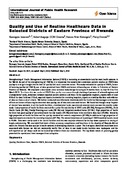| dc.contributor.author | Karengera, Innocent | |
| dc.contributor.author | Anguyo, Robert. DDM Onzima | |
| dc.contributor.author | Katongole, Simon Peter | |
| dc.contributor.author | Govule, Philip | |
| dc.date.accessioned | 2017-02-20T12:37:22Z | |
| dc.date.available | 2017-02-20T12:37:22Z | |
| dc.date.issued | 2016-05-03 | |
| dc.identifier.citation | Karengera, I., Anguyo, R. Onzima. DDM., Katongole, S. P., Govule, P., 2016. Quality and Use of Routine Healthcare Data in Selected Districts of Eastern Province of Rwanda. International Journal of Public Health Research, 4(2), pp. 5-13. | en_US |
| dc.identifier.issn | 2381-4829 (Print) | |
| dc.identifier.issn | 2381-4837 (Online) | |
| dc.identifier.uri | http://hdl.handle.net/20.500.12280/419 | |
| dc.description.abstract | Strengthening of Health Management Information System (HMIS) is becoming an unavoidable task for most health systems in the World. As part of the strengthening (of HMIS), it is imperative that stakeholders undertake periodic studies on HMIS-data quality so as to gain insight into the level of quality and cause corrective action. This study evaluated the quality of HMIS, factors influencing quality (of HMIS), use of data generated from HMIS and factors influencing use of data in 3 districts of Eastern Province of Rwanda. We employed a descriptive cross-sectional study design focusing on 9 months from 1st July 2012 to 31st March 2013. To achieve this we conducted HMIS data quality assessment through checking of presence of selected registers and client/patients’ cards, deviations between reported patient statistics and those in the appropriate registers, reports with at least 95% of the data fields well filled, expected reports received at the receiving hospitals, reports received by due date and evidence of data use from a set of criteria. We further conducted key informants interviews with the health facility managers and records officers on factors influencing the observed data quality; use of data and associated factors. We found that though every ‘register of interest’ was available in all the health facilities, client/patients’ cards experienced severely stock out over the months under study. Low proportion of health facilities attained the a priori for availability of ANC cards (58.0%), Partograms (56.8%), Child Health Cards (59.5%), Family Planning user cards (78.1%) and Outpatient medical forms (57.4%). High proportion of health facilities had good quality of (accurate) health facility reports (73.3%) and those in the electronic data base (70.6%). Similarly, high proportion of health facilities met the quality standard for content completeness (97.6%) in addition to high proportion of expected reports received at the receiving hospitals (97.7%). The overall timeliness of reporting of HMIS monthly reports stood at 93.8%. Data were rarely used in the health facilities and this was majorly enhanced by the top-down approach to setting of targets and planning. We concluded that levels of data accuracy, completeness and timeliness in the situation of Rwanda did not match the rhetoric that data quality in health systems in developing countries is poor. The few lapses identified could have been associated with factors we did not statistically verify. Use of data in our study health facilities was inadequate and the self-reported use (of data) could not be backed by evidence from our observations. The top-down nature of planning greatly prevented the operational-level managers from using data. | en_US |
| dc.language.iso | en | en_US |
| dc.publisher | International Journal of Public Health Research | en_US |
| dc.subject | Healthcare Data | en_US |
| dc.subject | Quality | en_US |
| dc.subject | Routine HMIS | en_US |
| dc.title | Quality and Use of Routine Healthcare Data in Selected Districts of Eastern Province of Rwanda | en_US |
| dc.type | Article | en_US |


